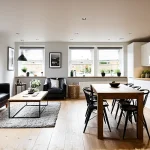Essential Steps for Designing a Minimalist Interior in a UK Home
Creating a minimalist interior design UK requires thoughtful planning, beginning with assessing your current space. Decluttering is crucial: remove unnecessary items to open up your rooms and promote simplicity. This step sets the foundation for effective minimalism and helps you identify which possessions truly add value to your life.
Next, define your minimalist vision tailored specifically to UK properties. Consider your home’s architecture and layout—whether you live in a period terrace or a modern apartment—so your design complements the space’s character. For example, preserving period features while applying minimalist aesthetics creates a balanced blend of old and new.
Also to read : What are the best ways to declutter your UK living space?
Developing a simple and functional floor plan is essential. UK home layouts often feature narrow halls and compact rooms. Designing with flow and usability in mind ensures every inch serves a purpose, fostering an uncluttered environment. Think about multi-functional furniture and open plan designs that accommodate daily living while maintaining visual simplicity.
By following these UK minimalist home tips, you establish a serene, purposeful space that marries function and style, ideal for contemporary British living.
Also to read : What are the top tips for organizing small UK spaces?
Choosing Colours, Materials, and Furniture for UK Minimalist Interiors
When aiming for a minimalist interior design UK style, choosing the right colours is paramount. Opt for neutral and muted colour palettes UK homeowners favour, such as soft greys, off-whites, and subtle beiges. These colours work well in small and period spaces, creating a sense of openness without overpowering existing architectural features.
In terms of furniture, selecting minimalist furniture UK styles that emphasise clean lines, simplicity, and functionality enhances the minimalist ethos. Popular UK retailers offer pieces crafted from natural materials like oak, ash, and beech wood, which complement minimalist interiors while adding warmth and texture. Scandinavian-influenced designs often fit well within UK minimalist home tips, known for their practicality and understated elegance.
Materials also play a crucial role. The best materials for minimalist homes in Britain are those that endure the local climate—timber treated for moisture resistance, wool textiles, and ceramics that provide tactile interest yet remain simple. These materials blend durability with minimalist aesthetics, ensuring your home stays fresh and functional year-round. Choosing correct colours, materials, and furniture collaboratively helps establish a timeless, calming space tailored for UK interiors.








